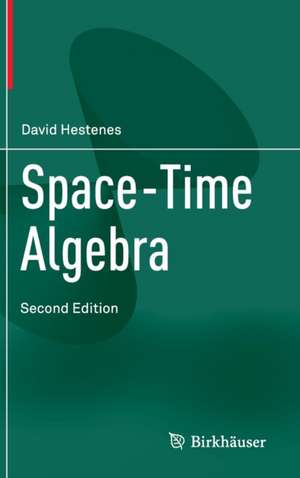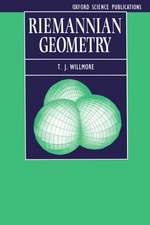Space-Time Algebra
Autor David Hestenes Cuvânt înainte de Anthony Lasenbyen Limba Engleză Hardback – 11 mai 2015
At its heart is the use of Clifford algebra to unify otherwise disparate mathematical languages, particularly those of spinors, quaternions, tensors and differential forms. It provides a unified approach covering all these areas and thus leads to a very efficient ‘toolkit’ for use in physical problems including quantum mechanics, classical mechanics, electromagnetism and relativity (both special and general) – only one mathematical system needs to be learned and understood, and one can use it at levels which extend right through to current research topics in each of these areas.
These same techniques, in the form of the ‘Geometric Algebra’, can be applied in many areas of engineering, robotics and computer science, with no changes necessary – it is the same underlying mathematics, and enables physicists to understand topics in engineering, and engineers to understand topics in physics (including aspects in frontier areas), in a way which no other single mathematical system could hope to make possible.
There is another aspect to Geometric Algebra, which is less tangible, and goes beyond questions of mathematical power and range. This is the remarkable insight it gives to physical problems, and the way it constantly suggests new features of the physics itself, not just the mathematics. Examples of this are peppered throughout ‘Space-Time Algebra’, despite its short length, and some of them are effectively still research topics for the future.
From the Foreward by Anthony Lasenby
Preț: 724.63 lei
Preț vechi: 883.69 lei
-18% Nou
Puncte Express: 1087
Preț estimativ în valută:
138.66€ • 148.27$ • 115.61£
138.66€ • 148.27$ • 115.61£
Carte tipărită la comandă
Livrare economică 17 aprilie-01 mai
Preluare comenzi: 021 569.72.76
Specificații
ISBN-13: 9783319184128
ISBN-10: 3319184121
Pagini: 102
Ilustrații: XXIV, 102 p.
Dimensiuni: 155 x 235 x 15 mm
Greutate: 0.36 kg
Ediția:2nd ed. 2015
Editura: Springer International Publishing
Colecția Birkhäuser
Locul publicării:Cham, Switzerland
ISBN-10: 3319184121
Pagini: 102
Ilustrații: XXIV, 102 p.
Dimensiuni: 155 x 235 x 15 mm
Greutate: 0.36 kg
Ediția:2nd ed. 2015
Editura: Springer International Publishing
Colecția Birkhäuser
Locul publicării:Cham, Switzerland
Public țintă
ResearchCuprins
Preface to the Second Edition.- Introduction.- Part I:Geometric Algebra.- 1.Intrepretation of Clifford Algebra.- 2.Definition of Clifford Algebra.- 3.Inner and Outer Products.- 4.Structure of Clifford Algebra.- 5.Reversion, Scalar Product.- 6.The Algebra of Space.- 7.The Algebra of Space-Time.- Part II:Electrodynamics.- 8.Maxwell's Equation.- 9.Stress-Energy Vectors.- 10.Invariants .- 11. Free Fields.- Part III:Dirac Fields.- 12.Spinors.- 13.Dirac's Equation.- 14.Conserved Currents.- 15.C, P, T.- Part IV:Lorentz Transformations.- 16.Reflections and Rotations.- 17.Coordinate Transformations.- 18.Timelike Rotations.- 19.Scalar Product.- Part V:Geometric Calculus.- 20.Differentiation.- 21.Coordinate Transformations.- 22.Integration.- 23.Global and Local Relativity.- 24.Gauge Transformation and Spinor Derivatives.- Conclusion.- Appendices.- A.Bases and Pseudoscalars.- B.Some Theorems.- C.Composition of Spacial Rotations.- D.Matrix Representation of the Pauli Algebra.
Textul de pe ultima copertă
This small book started a profound revolution in the development of mathematical physics, one which has reached many working physicists already, and which stands poised to bring about far-reaching change in the future.
At its heart is the use of Clifford algebra to unify otherwise disparate mathematical languages, particularly those of spinors, quaternions, tensors and differential forms. It provides a unified approach covering all these areas and thus leads to a very efficient ‘toolkit’ for use in physical problems including quantum mechanics, classical mechanics, electromagnetism and relativity (both special and general) – only one mathematical system needs to be learned and understood, and one can use it at levels which extend right through to current research topics in each of these areas.
These same techniques, in the form of the ‘Geometric Algebra’, can be applied in many areas of engineering, robotics and computer science, with no changes necessary – it is the same underlying mathematics, and enables physicists to understand topics in engineering, and engineers to understand topics in physics (including aspects in frontier areas), in a way which no other single mathematical system could hope to make possible.
There is another aspect to Geometric Algebra, which is less tangible, and goes beyond questions of mathematical power and range. This is the remarkable insight it gives to physical problems, and the way it constantly suggests new features of the physics itself, not just the mathematics. Examples of this are peppered throughout ‘Space-Time Algebra’, despite its short length, and some of them are effectively still research topics for the future.
From the Foreward by Anthony Lasenby
At its heart is the use of Clifford algebra to unify otherwise disparate mathematical languages, particularly those of spinors, quaternions, tensors and differential forms. It provides a unified approach covering all these areas and thus leads to a very efficient ‘toolkit’ for use in physical problems including quantum mechanics, classical mechanics, electromagnetism and relativity (both special and general) – only one mathematical system needs to be learned and understood, and one can use it at levels which extend right through to current research topics in each of these areas.
These same techniques, in the form of the ‘Geometric Algebra’, can be applied in many areas of engineering, robotics and computer science, with no changes necessary – it is the same underlying mathematics, and enables physicists to understand topics in engineering, and engineers to understand topics in physics (including aspects in frontier areas), in a way which no other single mathematical system could hope to make possible.
There is another aspect to Geometric Algebra, which is less tangible, and goes beyond questions of mathematical power and range. This is the remarkable insight it gives to physical problems, and the way it constantly suggests new features of the physics itself, not just the mathematics. Examples of this are peppered throughout ‘Space-Time Algebra’, despite its short length, and some of them are effectively still research topics for the future.
From the Foreward by Anthony Lasenby
Caracteristici
Spacetime Algebra (STA) provides a unified, coordinate-free mathematical framework for both classical and quantum physics STA reduces electrodynamics to a single Maxwell equation with explicit kinship to Dirac's equation STA reveals hidden geometric structure in Dirac’s equation with new insight into the role of complex numbers in quantum mechanics STA offers a novel gauge theory approach to quantum mechanics and General Relativity Includes supplementary material: sn.pub/extras
















